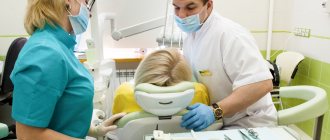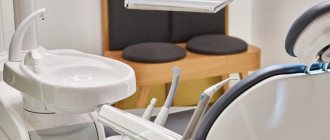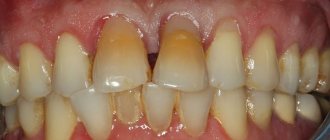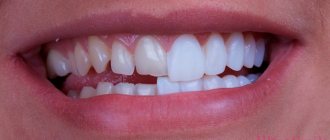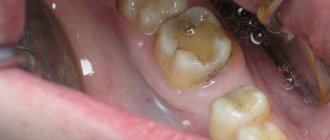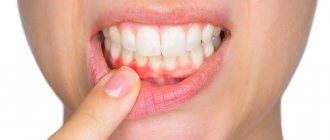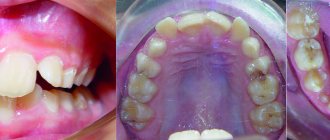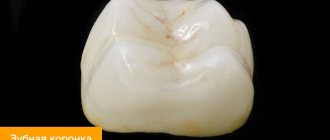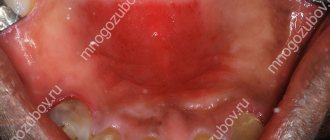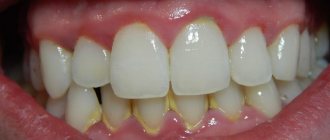Attachment (“attachment”, in English means attachment or joining) are locking or hinged fasteners that securely fix the prosthesis in its place. The device has the form of a structure that consists of two plates inserted into each other. The first part is called the matrix and is attached to the tooth or crown. The second part is connected to the denture; it is called the patrix.
What is a prosthesis with attachments?
Attachment (from the English attachment “attachment”) is a locking or hinged fastening that allows parts of one structure to be securely fixed together, i.e. prosthesis. In essence, it is a micro-lock that provides a strong and reliable connection between the supporting teeth and the prosthesis.
On a note! Sometimes attachments are called attachments, that is, they skip the letter “t” at the end of the word. But based on the English sound, the first name is still correct.
The attachment itself consists of two parts - a patrix and a matrix. The patrix is most often located in the supporting crown (less often - in the prosthesis itself). It can be made in the form of a ball or cylinder, cube or rack. The matrix is the second part of the micro-lock, which is located mainly in the prosthesis (less often in the root). It is hollow, made in the form of a recess, and is placed under the artificial gum inside the prosthesis. When fixing the device, the male enters the matrix, and they snap into place.
Materials for the manufacture of matrices and patrixes are plastic or metal. Often the patrix is made of metal, and the matrix is made of plastic.
Alternative options
If you want to save a little on removable prosthetics, then it makes sense to give preference to a model with locks - clasps. These can be parts made of metal, plastic or rubber that surround the crown or abutment tooth, thereby ensuring fixation of the orthopedic apparatus. They are not as aesthetically pleasing and convenient as attachments, but to this day they remain the most common option for attaching clasp dentures.
This is what a prosthesis with clasps looks like
It is worth noting that the best solution to the problem of partial and complete adentia is dental implantation. Only by replacing dental roots with full-fledged titanium analogues can you completely restore the functionality of the dental system and stop atrophic processes in bone tissue. Today, this is the most optimal option for restoring a smile, especially since modern dentists increasingly give preference to one-stage treatment protocols - in the shortest possible time and without the need for bone tissue augmentation.
Read more about implantation with immediate loading in our special material >>>
What types of structures can be fixed with attachments?
Such a fastening element can be provided in clasp dentures, as well as in any partial removable devices (intended to restore part of the teeth in the mouth), made of nylon, acrylic, and monomer-free plastics. For fixation on attachments, it is necessary that the abutment teeth or at least their roots (at least two pieces) are preserved in the patient’s mouth, on which artificial inlays or crowns with one of the fastening elements - the male can be installed. If there are no “supports” in the mouth, then this type of structure cannot be installed.
Such products are also called conditionally removable, because the patient does not need to remove them from the mouth on a permanent basis, like completely removable devices.
Alternative prosthetic methods
To reduce the cost of prosthetics, you can use an alternative option that replaces attachments - these are structures on clasps (from the German klammer - “clamp, bracket”), hooks made of rubber, metal or plastic, clasping the crown of the tooth. In this way, the support-retaining function of the prosthesis is realized. Clasps now remain the most popular way to secure customized dental products that replace real teeth.
Structurally, the clasp consists of:
- shoulder or ring (covers the support tooth);
- body (main part);
- a process immersed in an acrylic base (attached to the body of the clasp and the arch of the clasp prosthesis);
- occlusal lining (a layer located in the chewing part of the crown and distributing the load);
- frontal lining (installed in the area of the front teeth).
According to the observations of specialists involved in prosthetics, when using clasps instead of attachments, patients may experience some complications or negative consequences. This happens most often due to the use of cheap, low-quality materials or non-compliance with operating rules. An allergic reaction to some materials used in manufacturing may also develop.
This article was checked and approved by the doctor Boris Yurievich Borodin.
Classification of attachments by functional features
Clinical situations in which prosthetics are indicated are individual, therefore in dentistry there are several types of designs that differ in their functional features.
By location
- intracoronal: the patrix does not protrude beyond the hard tissues of the supporting tooth,
- extracoronal: when part of the attachment is glued or soldered over the crown. This type of fastening is rarely used, because Dentures installed in this way make oral hygiene difficult; bacterial plaque is deposited on the fastening elements, which is difficult to remove without the use of floss and irrigator. Yes, and they hold up worse,
- root: the patrix is located on the root,
- intraradicular: the patrix is located on the base of the prosthesis and is placed in the root.
By load distribution
Experts distinguish between movable and rigid locking structures. In hard ones, the matrix and patrix are motionless relative to each other, and then the load falls entirely on the supporting teeth. In mobile or labile teeth, the matrix and patrix are connected in such a way that the natural mobility between the parts is preserved, which allows the load to be distributed between the “bearing” teeth and the mucosa.
By type of connection
Locking structures attach the matrix to the patrix in different ways. For example, the friction method (using friction) is used in all designs with grooves, but the mechanical method is used in designs with a ball-shaped (push-button) lock. There is also a magnetic method, when parts of the product are attracted to each other by a magnet, and a screw method, when one part is connected to another using a screw thread. In addition, there are combined connection methods, most often mechanical-friction.
By production
Today there are two types of attachments. The first is standard or template (precision), manufactured in a factory - it is subsequently connected to the prosthesis by welding. The second option is a fastening system created in laboratory conditions (semi-precision) using special modeling casts. That is, for a specific patient.
On a note! The best manufacturers of locking attachments, according to professional orthopedic dentists: concern Rhein-83 (Italy), Bredent1 (Germany), Alvadent (Russia), CENDRES & METAUX SA DENTAL (Switzerland), Degussa (Germany).
Attachments can also differ in size - macro and micro.
Application of prosthetic technology
Prosthetics using attachments has been used in dentistry for quite a long time, since the 19th century. Over the years, many specialists have worked to improve them, and today there are more than 100 developments. There are several types of fastening:
- extradental;
- articulated;
- friction activated locks;
- non-adjustable sliding locks;
- push-button latches;
- combined hinge locks.
Attachments are used for clasp fixation of leveling; it does not look entirely aesthetically pleasing, but they are easy to care for. The system ensures reliable fastening of the prosthesis to the tissues and does not allow it to move. The device does not interfere with jaw movement, which allows you to chew food without hindrance.
Types of fastenings
To attach the removable part to the static one (that is, the prosthesis itself to living teeth), you need to make a mount. Depending on which jaw the patrix will be on, what load it will take on, and also based on individual characteristics, designs with different types of attachments can be offered:
- spherical: this is the most common type of fastening, reminiscent of a button on clothing. On the static surface (holding tooth) there is a groove into which a device with a ball-shaped tip fits. In some cases, the opposite happens - it all depends on the clinical situation,
- rod (beam): this is the second most popular type, allowing prosthetics to be performed in cases of large tooth loss. The essence of the method is that crowns are put on the supporting teeth, to which a bar (beam) is welded. It extends over the entire toothless part of the gum. A counter rod (matrix) is made on the removable surface, which accurately follows the curves of the male and fits precisely into the grooves on it. Such systems provide a strong hold during chewing and at the same time firmly hold the supporting units,
- rail: on the matrix there is a T-shaped process, which fits into a T-shaped groove on the male.
Indications for prosthetics with locks
General indications are partial absence of teeth, impossibility of installing implants due to health reasons or due to the financial capabilities of the patient. The products are also used when it is impossible to secure removable dentures, for example, when the patient has abnormalities in the structure of the palate.
On a note! The production of locking attachments is used in the absence of chewing teeth on both one and two sides. Designs based on spherical attachments are also used to restore single defects.
However, it is important to understand that each type of prosthesis with attachments has its own series of indications and contraindications. For example, a rod design in clasp prosthetics with attachments is indicated for periodontal diseases, because it allows you to immobilize (fix) abutment teeth and distribute the chewing load between healthy and diseased teeth. At the same time, the rod lock is not used in case of partial destruction of the supporting units.
Contraindications for prosthetics
General contraindications are the absence of supporting teeth or roots (minimum 2 pieces), into which it is impossible to install a patrix.
The presence of cardiovascular, endocrine and other severe chronic diseases prevents the installation of dentures if tooth preparation is required.
Pathological abrasion of enamel is also a contraindication for the installation of locking systems.
In case of irreversible periodontal pathologies (periodontitis and periodontal disease in the generalized stage), causing mobility of supporting teeth, prosthetics with attachments cannot be considered, because The reliability of fastening the devices in this case leaves much to be desired.
What determines the choice of fastening?
The choice of type of fastening depends on the situation in the oral cavity: what condition the natural teeth are in, whether there is a history of gum and periodontal diseases, whether there are other orthopedic products (bridges, crowns), how many consecutive teeth are missing in a row, etc.
In the absence of one or two teeth in a row, products with attachments are most often used (especially if for some reason it is impossible to carry out implantation). Here the orthopedic surgeon will choose between single crowns with a ball-shaped attachment and a barbell attachment.
When prosthetizing molars, especially if they are missing on both sides, the orthopedist will most likely choose a clasp system with push-button fastening, and if there are no chewing units on only one side, then the fastening will most likely be rail-based.
There are situations when a patient’s crown is destroyed, but the roots are preserved. In this case, the structure will be attached in a push-button manner.
Are there any contraindications
Despite the abundance of advantages, prosthetic structures with locks have a number of installation restrictions. Here are the main contraindications:
- the supporting elements are severely damaged and will not be able to provide reliable fixation,
- there are pockets of inflammation on the roots of the remaining teeth,
- severely exposed roots are a consequence of periodontal disease,
- small crown height (up to 5 mm),
- Parkinson's disease, arthritis and other diseases that limit the mobility of the hands and significantly complicate the process of removing and installing a prosthesis with a complex attachment mechanism.
You should not resort to this type of prosthetics if you do not have the opportunity to see your dentist at least once every six months. It is also necessary to provide high-quality oral care, including before installing an orthopedic device. To do this, experts recommend undergoing professional cleaning to remove plaque and deposits in advance.
Advantages of lock fastenings
- high smile aesthetics: the fastening elements are located inside the prosthesis, therefore, others will not even notice that you are wearing “artificial teeth”,
- reliable fixation of the device in the mouth: there is no need to worry about the prosthesis falling out of the mouth at the most inopportune moment,
- reducing the chewing load on the gums and mucous membranes,
- uniform distribution of chewing load,
- a quick period of adaptation and habituation,
- better protection of bone tissue from atrophy compared to completely removable systems,
- taste sensations and diction are not impaired: thanks to this type of fastening, it is possible to make the structure lighter and more compact, which is especially important for people who restore teeth in the upper jaw - it does not contain a massive palatal bridge, which causes discomfort and blocks the palatal receptors and salivary glands,
- When worn out, the locks can be replaced with new ones,
- there is no need to remove the denture from the mouth,
- devices on attachments do not require complex hygienic care.
Disadvantages of classic removable dentures
Standard models of plate dentures usually provide for fastening using clasps - a special wire structure made in the form of hooks. Two phenomena can provide additional fixation strength:
- cohesion – tight contact of the structure due to the repetition of the anatomical shape of the patient’s jaws,
- adhesion - the effect of suction of the prosthesis to the palate or alveolar arch of the lower jaw.
However, this is often not enough for a strong and reliable fixation. Then the patient has to resort to the help of auxiliary means - fixing creams and gels. The massive palatal bridge of dentures for the upper jaw significantly complicates and prolongs the process of adaptation, distorts taste sensations and impairs diction. As for the lower jaw, here the area of contact between the prosthesis and the alveolar process is smaller, which leads to rapid loosening of the structure. There is a risk of the prosthesis falling out during active use of the tongue, for example, when talking or eating.
Classic dentures can fall out while eating
In this regard, the most advantageous option may be a clasp prosthesis. It lacks a massive palatal overlap, which ensures the proper level of comfort. Today, this is one of the best constructive solutions to the problem of partial edentia (there are no complete clasp dentures). Separately, we can highlight a model with a splinting effect - it allows you to secure the remaining loose teeth in the desired position. It is worth noting here that the “clasp” can be either on clasps (hooks) or on attachments - the latter option is certainly more preferable.
Disadvantages of lock systems
- high cost of the product,
- high requirements for the technical part of manufacturing: the presence of a high-precision cutter, an apparatus for casting molds and frames, the presence of a highly professional technician trained in the specifics of manufacturing structures using attachments,
- limited list of indications for installation: structures cannot be installed with complete edentia,
- the need for preparation of supporting units,
- fragility of lock fastenings: after 2-5 years they wear out, break and need to be replaced,
- load on living teeth: in general, the service life of such devices directly depends on the condition of the “supports”, and since Since they bear a large share of the load, they quickly collapse. The load on the “supports” is especially strong if the patient is missing a large number of teeth.
Popular manufacturers of lock mechanisms
Today, there are several leading companies in the production of prosthetic devices and their components. These include the following representatives of the orthopedic products market:
- Bredent is a German company that specializes in the development and production of high-quality sphere-shaped attachments,
- Rhein-83 - a manufacturer from Italy produces vertical and spherical locking fasteners for orthopedic devices,
- Cendres metaux Sa dental - a company from Switzerland produces almost all types of attachments for dentures.
Comfort, aesthetic appearance and ease of care are the key criteria that a modern, high-quality denture must meet. Designs based on attachments have received special recognition from both specialists and patients. Overall, this is a more advanced and improved option that solves many of the problems of removable prosthetics.
- Perevezentsev A.P. Attachments in implantology, 2004.
The process of installing locking devices
Before installing the structure, it is important to sanitize the oral cavity, cure caries, check the condition of the gums, get rid of all sources of inflammation, and carry out professional cleaning. This is the first stage of installing the prosthesis.
At the second stage, when the oral cavity is sanitized, it is important to prepare the supporting units. The doctor necessarily removes the nerve, cleans the root canals, performs a filling and creates a depression.
At the third stage, the doctor makes impressions of the jaws, which are subsequently sent to the laboratory so that the technician can make a structure that meets the individual anatomical characteristics of the patient.
Next comes fitting and fitting of the product. When all the shortcomings have been eliminated, the doctor installs the structure in its intended place and gives the patient recommendations for wearing the prosthesis, teaches how to remove and put it on (although in general there should not be a need to perform these manipulations often).
Maintenance of lock systems
It is easier to care for a prosthesis with locks than for removable structures, but it also requires some skill and discipline.
Firstly, it is important to pay great attention to oral hygiene, because microbes will accumulate at the site of the patrix and matrix couplings. That is why doctors advise using additional oral care products - floss, irrigators, special brushes.
Secondly, dentures need to be removed and processed manually from time to time, and rinsed with special antiseptic solutions. Doctors recommend doing this before going to bed, although at first, while adaptation to the product occurs, it is better not to take it off at night.
Thirdly, the locking part of the structure is its weakest point, which means that after long-term use, defects may occur in it: chips, scratches, deformations. Therefore, it is important to be examined by an orthopedist at least twice a year so that he can identify defects in time and replace the matrix. To protect the fastening elements from premature wear and damage, you need to be careful when consuming solid foods and not putting excessive chewing load on the prosthesis.
It is also important to pay attention to the supporting teeth and mucous membranes, because... The service life of the devices will depend on their condition. If the “supports” are damaged, then the structures will have nothing to support them.
The dentist knows which attachment to choose
Fasteners began to be used in dentistry back in the 19th century. Due to the fact that their effectiveness has been proven over the years, today there are more than 100 different types of attachments.
These orthodontic devices have the following benefits for doctors and patients:
- simple and easy to use;
- strong lock fastening;
- the chewing load on the jaw is distributed evenly;
- easy to disassemble and adjust if necessary;
- do not affect the speech apparatus and articulation;
- This type of prosthesis does not need to be removed at night.
Usually, before prosthetics, the dentist carries out a thorough treatment of the patient’s teeth and gums, so to speak, prepares the oral cavity. Then clinical and laboratory studies and direct production of prostheses are carried out. After this, a control “fitting” takes place. Having received an accurate impression, the dental technician adjusts the prosthesis and, at the next stage, installs it using an attachment in the patient’s oral cavity.
Modern dentists follow new products and try to choose materials of the highest quality. After all, not only the health and quality of life of the patient, but also their reputation as specialists depends on this. A good attachment plays an important role in successful prosthetics, because it is thanks to it that the prosthesis remains in a stable position for many years and does not bother its owner.
